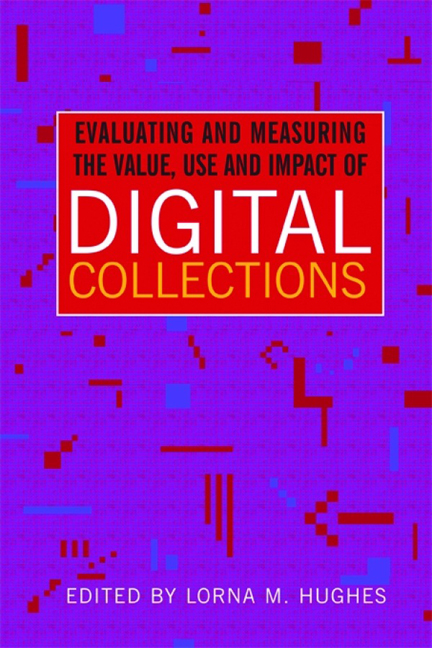Book contents
- Frontmatter
- Contents
- Figures and tables
- Foreword
- Acknowledgements
- The contributors
- 1 Introduction: the value, use and impact of digital collections
- Part 1 Digital transformations in libraries, museums and archives
- Part 2 Understanding and measuring the use, impact and value of digital collections
- 5 A strategic approach to the understanding and evaluation of impact
- 6 User needs in digitization
- 7 Measuring impact and use: scholarly information-seeking behaviour
- 8 The value and impact of digitized resources for learning, teaching, research and enjoyment
- Part 3 Enhancing the future impact and value of digital collections
- References and further reading
- Index
- Miscellaneous Endmatter
- Miscellaneous Endmatter
5 - A strategic approach to the understanding and evaluation of impact
from Part 2 - Understanding and measuring the use, impact and value of digital collections
Published online by Cambridge University Press: 08 June 2018
- Frontmatter
- Contents
- Figures and tables
- Foreword
- Acknowledgements
- The contributors
- 1 Introduction: the value, use and impact of digital collections
- Part 1 Digital transformations in libraries, museums and archives
- Part 2 Understanding and measuring the use, impact and value of digital collections
- 5 A strategic approach to the understanding and evaluation of impact
- 6 User needs in digitization
- 7 Measuring impact and use: scholarly information-seeking behaviour
- 8 The value and impact of digitized resources for learning, teaching, research and enjoyment
- Part 3 Enhancing the future impact and value of digital collections
- References and further reading
- Index
- Miscellaneous Endmatter
- Miscellaneous Endmatter
Summary
Introduction
For almost two decades the UK has enjoyed significant amounts of spending on the digitization of scholarly and cultural material. It has been estimated that, since the mid- 1990s, £130 million has been spent on the creation of digital content in the UK (JISC, 2005). However, it is now evident that we are experiencing a time of unprecedented challenges and changes within the UK. This is the case with both the information ecosystem that we now inhabit and the new economic climate that exists. This convergence of circumstances has led to concepts such as impact and value reestablishing themselves as important factors for academic institutions and the resources they develop and for the bodies and organizations that fund this important work.
We should avoid the assumption that the desire to better understand the impact and value of digital resources and the uses to which these resources are being put is something new, and the result of this ‘perfect storm’ of circumstances. Most funding bodies have long expressed the need for the projects they fund to address issues of impact. As an example, the National Science Foundation in the USA has been asking its projects to consider the impact of its work since the early 1990s. There have also been a number of studies and guides that have attempted to address the needs of projects and resources in assessing the usage and impact of digital resources, for example: user analysis (Warwick et al., 2006; Harley et al., 2006); libraries and the impact of digital resources (Spiro and Segal, 2007); and understanding your audience (Quirk et al., 2009).The result of this growing body of research is an increased understanding of the different impacts that digital resources are having within the scholarly community, and the potential benefits they could bring to, and value they could have for, this community.
However, while it is undoubtedly a cliché, there is some truth in the argument that until relatively recently digital resources have often been created with a ‘build it and they will come’ mentality (Warwick et al., 2008).
- Type
- Chapter
- Information
- Publisher: FacetPrint publication year: 2011
- 1
- Cited by

